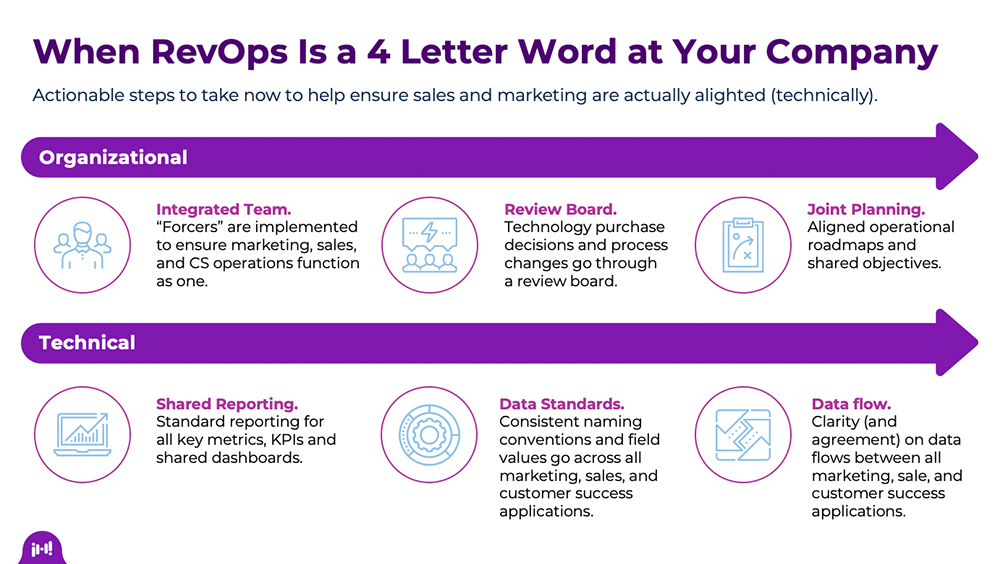Blog

There are so many companies that talk of alignment every day, and I mean EVERY DAY. It has become a buzz word rendered meaningless and unimpactful. Yet, alignment is still important, and we continue to write about it. Why? Because there’s hardly anyone doing it—well. In order to be aligned, your technology and business processes need to be integrated. It’s so much more than recurring meetings between marketing, sales, and customer success teams. If the technology and your business processes aren’t integrated then alignment is not going to happen. A clear path forward to driving technology and business process integration is through RevOps—specifically, a centralized RevOps function.
However, for many organizations jumping right into a centralized revenue operations function isn’t feasible. For example, most companies over $50m will have operations teams in place, all with their own norms, procedures, and processes. These organizations should focus on driving operational alignment first. In essence, don’t boil the ocean. Start with a pot of water.
If you don’t have a centralized RevOps function in place, but want to get there, take steps towards it first, by focusing on driving operational alignment. Don’t take the plunge all at once.
Here are actionable steps to take now to help drive operational alignment between sales and marketing and customer success. I’m not going to walk you through a 12-step model on alignment. We have better things to talk about today. I will, however, tell you that operational alignment comes down to two things: your organization and your technology.

Organizational.
Marketing and sales and customer success operations need to be integrated if they ever hope to be aligned. If there’s no relationship between the teams, then there’s no natural collaboration, which is vital to supporting a centralized RevOps function.
- Integrated team. If you want your teams integrated, then you need to create a physical environment that allows it to happen. To do this, force it AND let it grow organically. Sounds contradictory, right? Not necessarily. Force it to happen by sitting the operations teams next to each other, but then allow everything else, mainly the relationships, to happen organically. To stage the ideal environment for your integrated team their desks need to be next to each other, and if not, use desk swaps. A desk swap would be once a week, a member of the marketing ops team sits with the sales ops team, a sales ops member with customer success, and vice versa. Now that’s not going to happen right now with everyone working from home due to COVID-19, but in the interim, you can schedule a weekly sync call. You could also simply CC each other on your weekly status updates via email and the like. Once this integrated environment is established, the operations teams will organically find common ground, mingle, and eventually collaborate.
- Operations review board. Before technology is purchased or process changes are made, big decisions need to go through an operations review board. The operations review board needs to ponder questions such as why it’s needed, what it impacts, and what it requires. Having an operations review board is crucial to keeping everyone on the same page. Years ago, I was working at a company where I ran marketing operations. There was a time I went on vacation, and when I returned, I found out that Sales purchased a new CRM system. Also, I was not the only one unaware of this massive change. The rollout of the CRM reinforced siloed thinking, siloed reporting, and siloed business processes. What is the lesson here? Create an operations review board, and have the finance team require the review boards approval on all tech spend over X amount of dollars. But while an operations review board helps prevent situations like the one I just described, it’s also about making informed operational decisions that look at the company as a whole, instead of optimization for another individual function.
- Joint planning. It’s not uncommon that operations teams only casually or opportunistically meet, which is why it’s important to hold, at minimum, a quarterly meeting. Ideally, there should be monthly meetings between the heads of marketing, sales and customer success operations, and quarterly for the teams as a whole to discuss goals and priorities. Make sure marketing, sales, and customer success operations know what each other is working on now and what they plan to work on next week/month/quarter. Force this to happen with a mandatory monthly meeting. In these meetings, it’s important to have a shared roadmap across these functions to address many of the challenges mentioned in my previous article. Above all, a shared roadmap allows for transparency between the different groups and promotes open communication.
Technical.
Technology is the backbone of every department – it’s what enables and reinforces processes and procedures and what makes reporting possible. Technology also helps unify (or disrupt) departmental alignment.
- Shared reporting. It’s vital that every stakeholder understands which metrics and performance indicators are most important and how you’re going to measure them. While shared reporting is a main benefit of RevOps, you don’t need to have a centralized RevOps function to agree on key metrics, reports, and KPIs that should be tracked regardless of the function or department. In doing so, don’t try to overhaul everything at once. Start by having the departments focus on the 10 most important reports that all of the functions use. From there, create a standardized report that all functions can go to when they need to know, for example, last quarter how many MQLs were created or pipeline opportunities. Finally, purge ALL other similar reports, so only the standard ones are used.
- Data standards. Of course, to have reporting that stitches together, you need to ensure your data across departments is standardized – this includes things such as ensuring naming conventions and field values are consistent across applications. Review the fields that are in all your systems and see if they add up. Likely, you’ll find differences in field names, picklist values, and validation, which need to be addressed. Like with shared reporting, focus on the core fields first, and then work your way back through the rest.
- Data flows. Lastly, you need to have a strong understanding of how that data flows to and from other applications. Out of all your different investments in sales, marketing, and customer success, which update other applications and systems? Remember, the source of the truth does not come from a single system—the source of the truth varies based on the item in question. E.g. Marketing tactic performance is likely best measured from one’s marketing automation platform, a list of active customers from one’s finance system and details on sales pricing strategy from a Sales Configure, Price Quote (CPQ) application.
The Iron Horse insight.
There is often a visceral reaction to immediately jump into RevOps after the organization agrees to go that route. This instant change may work for organizations that already practice a high-level of integration and collaboration between marketing, sales, and customer success, but this is otherwise a mistake. Instead, an organization should create engagement between its teams, first. There needs to be an organic, natural integration of the operations teams before transitioning to a centralized RevOps function, otherwise, an organization and its employees will experience a great deal of disruption and frustration.
Subscribe to our blog.
Get unstuck with the most interesting business ideas and our insights delivered to your inbox.